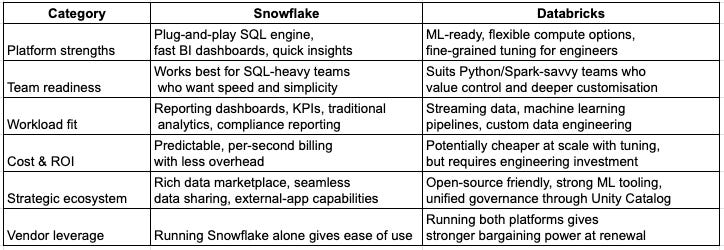Databricks vs Snowflake: Aussie CTO Decision Matrix
Match your team’s skills, goals and data maturity with the right platform
As a CTO in Australia, you face a constant trade-off: move fast with tools that give your team instant insights, or invest in platforms that offer more control and long-term flexibility. The wrong call doesn’t just cost money; it slows down projects, frustrates engineers, and drags out time-to-value.
That’s why the debate around Databricks vs Snowflake in Australia has become so charged. Both are powerful data platforms, but they are designed with different strengths in mind. Snowflake is often the go-to for teams that want a clean, reliable data warehouse with minimal overhead. Databricks leans into the data lakehouse model, giving more flexibility for machine learning, Python workflows, and large-scale analytics.
The challenge is simple: how do you match your company’s skills, budget, and growth plans with the right choice?
This article sets out a clear decision matrix for Aussie CTOs. You’ll get:
A side-by-side comparison of Databricks and Snowflake tailored to Australian business contexts
A breakdown of strengths, weaknesses, and use cases in plain English
Practical insights on cost, ROI, and team readiness
A framework to reduce risk and avoid buyer’s remorse
By the end, you’ll have the clarity to lead your data strategy with confidence, whether that means Snowflake, Databricks, or both.
Decision Matrix for Aussie CTOs
Choosing between Databricks and Snowflake in Australia isn’t just about features—it’s about matching the platform to your team’s skills, your company’s workloads, and the return you expect. To make it practical, here’s a side-by-side decision matrix designed for CTOs who need a clear path forward.
Insights for the Australian Market
Australian enterprises are at different stages of data maturity. Some, as Fujitsu’s APAC findings highlight, prioritise fast insights and business intelligence—where Snowflake tends to win. Others want flexibility for machine learning and advanced analytics, leaning towards Databricks.
The real challenge isn’t whether one platform is “better” than the other. It’s about aligning with your team’s strengths and making sure you’re not locked into costly re-platforming in two years. CTOs who’ve adopted both often do it for strategic leverage: having two vendors reduces lock-in risk and strengthens negotiation when contracts renew.
Aussie Data Reality & Local Context
Australian enterprises are in the middle of a fast data modernisation wave. The pressure isn’t just about storing information; it’s about turning data into decisions that directly impact revenue, customer experience, and compliance. Local CTOs are expected to cut through noise and deliver quick wins while still building a scalable data foundation for the future.
This is where the choice between Snowflake and Databricks in Australia becomes clear.
Snowflake fits the turn-key mindset. Many Australian CXOs prefer solutions that work out of the box, where teams can spin up BI dashboards, track KPIs, and generate insights without heavy engineering effort. Snowflake appeals here because it’s easy to run, predictable in cost, and supported by a wide ecosystem of partners who already operate in Australia.
Databricks appeals to the build-your-own mindset. Companies with strong engineering talent often want more flexibility, especially if machine learning, streaming, or data science is central to their strategy. These teams see Databricks as the platform that gives them deeper control, even if it means investing more time in tuning and optimisation.
Another local factor is cost predictability in AUD. Snowflake’s credit-based pricing is clear but can spike with heavy workloads, while Databricks can be tuned aggressively for savings if you have the right engineers. For Australian finance teams, the ability to forecast spend in local currency and align it with ongoing vendor support onshore matters is just as important as the technology itself.
The bottom line? In Australia, the decision isn’t just technical. It’s cultural and financial. CTOs who want a ready-to-go solution often lean towards Snowflake. Those who want flexibility and have the engineering muscle to back it up, lean towards Databricks. Some hedge their bets and run both buying speed on one side and control on the other.
Linked Strategies: Platform → Outcome
Technology choices are never made in a vacuum. They’re driven by pain points that block growth, aspirations for better outcomes, and the urgency to act now. Here’s how the decision between Snowflake and Databricks in Australia maps directly to business needs.
1. When reporting stalls
Pain: Slow dashboards, siloed data across departments, and executives waiting days for KPI updates.
Aspiration: A unified warehouse that delivers fast, reliable BI reporting.
Platform choice: Snowflake – plug-and-play SQL, predictable performance, and quick wins for business intelligence.
2. When machine learning projects stall
Pain: Delays in ML deployment, limited compute control, and teams stuck waiting on infrastructure.
Aspiration: Real-time insights, scalable compute, and full control of model training and deployment.
Platform choice: Databricks – flexible compute, ML-ready workflows, and advanced tuning for performance.
Why now matters
Both problems slow BI and delayed ML, are more than technical annoyances. They slow down revenue decisions, frustrate teams, and leave room for competitors to outpace you. Acting now with the right platform creates a competitive edge: Snowflake speeds up insights, while Databricks accelerates ML innovation. In some cases, using both ensures no strategic gap is left open.
Avoiding Buyer’s Remorse
Choosing between Databricks and Snowflake in Australia isn’t a one-shot decision. CTOs who jump too quickly often face buyer’s remorse, usually when the platform they’ve chosen doesn’t align with the team’s skills or the workloads that matter most. The smarter approach is to test before you commit.
Start small with trials
Run narrow, controlled evaluations instead of betting the farm. For example:
Snowflake trial: build a BI mock-up to test dashboard speed, data sharing, and ease of use with business analysts.
Databricks trial: run a small machine learning prototype to validate compute flexibility, Python workflows, and model deployment speed.
These smaller projects give you a clear read on ROI without tying up the entire organisation.
Blend both to reduce risk
Some Australian enterprises are finding value in using both Snowflake and Databricks as part of one strategy. Snowflake handles fast reporting and data sharing, while Databricks powers machine learning and advanced analytics. Running both doesn’t just ease technical risk; it also strengthens your hand in vendor negotiations when renewal time comes.
Invest early, benefit later
Cloud spend is a long game. Databricks can look expensive without tuning, but engineering time invested upfront often pays off in lower costs per workload over time. Snowflake may feel more predictable, but understanding usage patterns early will stop bill shocks down the line. Taking the time to align workloads, pricing models, and team readiness now gives you a better total cost of ownership later.
The reality is this: buyer’s remorse happens when decisions are rushed. Trial first, plan realistically, and keep leverage on your side. That way, your choice whether Snowflake, Databricks, or both drives outcomes, not regret.
Quick Reference: Pros & Cons
When decisions need to be explained to boards or non-technical executives, a clear pros and cons list helps cut through the noise. Here’s a quick reference comparing Snowflake and Databricks for Australian CTOs.
Snowflake – Pros
Fast, reliable SQL engine for reporting and dashboards
Easy data sharing and access to a growing marketplace of datasets
Minimal operational overhead – less time spent on cluster tuning and scaling
Backed by strong ecosystem support in Australia (Cloud Security Web, The Datapedia, Geekflare)
Snowflake – Cons
Limited machine learning tooling – requires add-ons like Snowpark for Python workloads
Less flexibility in tuning compute – you trade control for simplicity
Licensing in credits, which can feel restrictive, even when compute sits idle
Databricks – Pros
Full control: manage clusters, Spark tuning, and Python workflows with precision
Strong ML ecosystem – MLflow, collaborative notebooks, and model serving are built in
Handles streaming and unstructured data well, making it ideal for lakehouse architectures
Recognised globally for machine learning readiness and flexibility (The Datapedia, Geekflare)
Databricks – Cons
Requires more engineering effort – skilled teams are essential to get value quickly
Cost benefits come only when well-tuned – poor optimisation can lead to higher spend
More complexity to manage – flexibility means extra decisions around clusters, storage, and governance
This quick reference makes the trade-offs clear: Snowflake simplifies, Databricks empowers. Your decision depends on whether your business values speed to insights or engineering flexibility more.
Final Verdict for Aussie CTOs
Choosing between Databricks and Snowflake in Australia doesn’t come down to which platform is “better.” It comes down to alignment, matching your team’s strengths with the outcomes your business needs.
Pick Snowflake if your team values quick time to insight, SQL strength, and structured reporting.
Pick Databricks if your engineers thrive on control, machine learning pipelines, and performance tuning.
Use both when scale, vendor leverage, or strategic flexibility matter and your organisation has the technical maturity to manage them side by side.
The platforms are converging, but your business context will always shape the smarter choice.
Before locking in multi-year contracts, test your assumptions. If you’d like a partner to guide you through the process, I can help. I work with Australian enterprises to map skills, workloads, and ROI to the right data platform so your investment delivers results, not regrets.
Let’s help you map your team’s strengths to the right platform.




